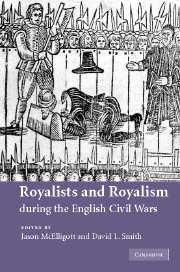Book contents
- Frontmatter
- Contents
- Notes on contributors
- Preface
- Abbreviations
- 1 Introduction: rethinking royalists and royalism
- 2 A lesson in loyalty: Charles I and the Short Parliament
- 3 The Court and the emergence of a royalist party
- 4 Varieties of royalism
- 5 Royalist reputations: the Cavalier ideal and the reality
- 6 Counsel and cabal in the king's party, 1642–1646
- 7 ‘I doe desire to be rightly vnderstood’: rhetorical strategies in the letters of Charles I
- 8 Royalists and the New Model Army in 1647: circumstance, principle and compromise
- 9 The royalist origins of the separation of powers
- 10 ‘A No-King, or a New’. Royalists and the succession, 1648–1649
- 11 The royalism of Andrew Marvell
- Subject Index
- Author Index
3 - The Court and the emergence of a royalist party
Published online by Cambridge University Press: 19 July 2009
- Frontmatter
- Contents
- Notes on contributors
- Preface
- Abbreviations
- 1 Introduction: rethinking royalists and royalism
- 2 A lesson in loyalty: Charles I and the Short Parliament
- 3 The Court and the emergence of a royalist party
- 4 Varieties of royalism
- 5 Royalist reputations: the Cavalier ideal and the reality
- 6 Counsel and cabal in the king's party, 1642–1646
- 7 ‘I doe desire to be rightly vnderstood’: rhetorical strategies in the letters of Charles I
- 8 Royalists and the New Model Army in 1647: circumstance, principle and compromise
- 9 The royalist origins of the separation of powers
- 10 ‘A No-King, or a New’. Royalists and the succession, 1648–1649
- 11 The royalism of Andrew Marvell
- Subject Index
- Author Index
Summary
This chapter begins with an obvious question that has never received a satisfactory answer: what role did the Court play in the emergence of a royalist party? To the extent that they have considered it at all, historians have usually taken one of two mutually incompatible positions with regard to this problem, neither entirely satisfactory. Some have treated the Court as the seedbed of royalism, an institution permeated by absolutist and crypto-Catholic values that provided the original core of the king's party and the ideology for which it fought. Despite its superficial plausibility, this view must confront the serious problem that several leading courtiers supported parliament in 1641, while others avoided active commitment by departing for the continent. Since the parliamentarian courtiers included two successive Lord Chamberlains, the Groom of the Stool, the Captain of the Gentlemen Pensioners, the Lord Admiral and a Secretary of State they cannot be considered a marginal group. Their existence lends substance to the rival hypothesis, lately favoured by revisionist historians, although its origins go back to Clarendon. This holds that the Court splintered and disintegrated in 1641, leaving Charles bereft of support until backbench MPs and conservative country gentry began rallying to him in reaction against the excesses of the parliamentary leadership, especially its attacks on episcopacy.
Although at first glance more compatible with the evidence, this interpretation also creates difficulties, not least in explaining the roles of the king and queen in the formation of their own party.
- Type
- Chapter
- Information
- Royalists and Royalism during the English Civil Wars , pp. 43 - 65Publisher: Cambridge University PressPrint publication year: 2007
- 1
- Cited by



